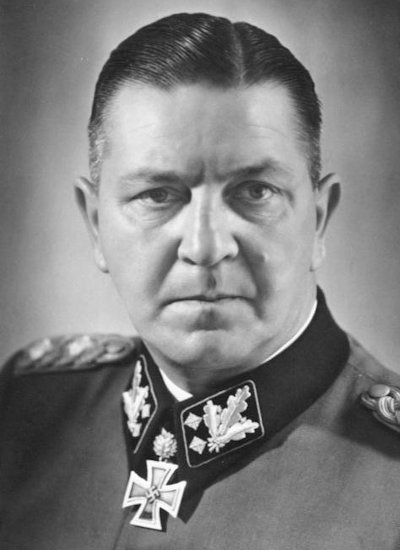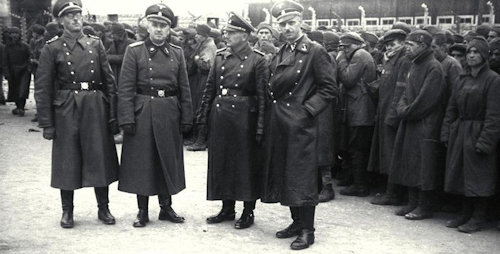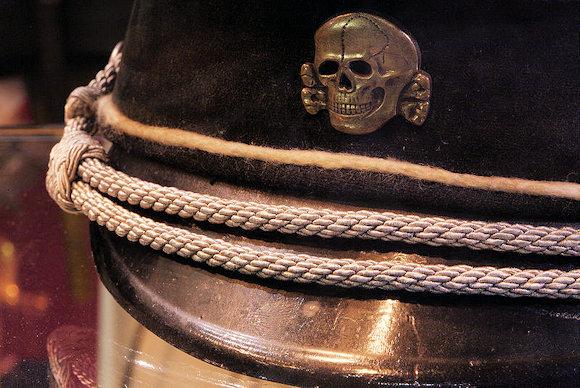SS-Totenkopfverbände, known as "Totenkopf", a name that evokes terror, a name that recalls human memory to the thought of death, destruction, a name linked to one of the formations of the Waffen SS more feared and hated in the history of the Second World War. The "Totenkopf" division continues to be identified as the archetype of Nazi terror applied not only on battlefields but also against unarmed civilians. The "SS-Totenkopfverbände", commonly abbreviated as SS-TV and translatable as "Head Unit of the Dead", were departments belonging to the body of the Schutzstaffel (SS), and used for the custody of concentration camps.
In March 1933, a few months after the admission of Adolf Hitler (1889-1945), the first "fields of work and re-education" were set up, within which to capture the enemies of the nascent National Socialist state, composed at first mainly by political and communist opposition opponents. The pretext for starting the persecution was provided by the fire of the Reichstag building (27 February 1933) seat of the German parliament. In Prussia and most of Germany, the first and most numerous fields were created by Hermann Göring (1893-1946), Führer's dolphin, and powerful Interior Minister of the Prussian state. Göring entrusted the administration of these fields, often extemporaneous and disorganized, to the "Sturmabteilung" (SA). Contrary to the disorganization of the Göring fields, the concentration camp of Dachau in Bavaria was set up, established by the efficient Heinrich Himmler (1900-1945), SS commander and rising star of the National Socialist Party. To carry out the guard service at Dachau internships, Himmler formed the "SS-Wachverbände" department with elements of the "Allgemeine-SS" of Monaco, entrusting the command, in conjunction with the field, to the SS -Oberführer Theodor Eicke (1982-1943), who soon became famous for both brutality and efficiency, transforming Dachau into a model field. Meanwhile, Himmler managed to subtract the control of part of the concentration camps to the jurisdiction of Göring and the "Sturmabteilung".
 The 30 June 1934 was a bloody scourge, organized by Himmler and Göring, against the SA and their commander Ernst Röhm (1887-1934), accused of plotting for the overthrow of Hitler. Eicke (pictured right), commander of Dachau, played an important role in the operation, commanding the unit that killed Röhm. Disqualified following the SA purge and agreed with Göring, Himmler obtained, among other things, the control of all the concentration camps of Germany and rewarded Eicke, promoting him to the rank of SS-Gruppenführer (general of division) and naming him, the 4 July 1934, "Inspekteur der Konzentrationslager und SS-Wachverbände" (inspector of concentration camps and guard units). Himmler assigned to Eicke the task of improving the discipline and morale of the "SS-Wachverbände" who until then had been recruited among the less motivated and efficient elements of the "Allgemeine-SS". In Himmler's and Eicke's mind it was clear that the special ward would have to be ready, efficient, and ruthless in anticipation of the future operations of internment of the enemies of the state, Jews and asocial.
The 30 June 1934 was a bloody scourge, organized by Himmler and Göring, against the SA and their commander Ernst Röhm (1887-1934), accused of plotting for the overthrow of Hitler. Eicke (pictured right), commander of Dachau, played an important role in the operation, commanding the unit that killed Röhm. Disqualified following the SA purge and agreed with Göring, Himmler obtained, among other things, the control of all the concentration camps of Germany and rewarded Eicke, promoting him to the rank of SS-Gruppenführer (general of division) and naming him, the 4 July 1934, "Inspekteur der Konzentrationslager und SS-Wachverbände" (inspector of concentration camps and guard units). Himmler assigned to Eicke the task of improving the discipline and morale of the "SS-Wachverbände" who until then had been recruited among the less motivated and efficient elements of the "Allgemeine-SS". In Himmler's and Eicke's mind it was clear that the special ward would have to be ready, efficient, and ruthless in anticipation of the future operations of internment of the enemies of the state, Jews and asocial.
By March 1935 the initial and chaotic structure of the camps was completely reorganized by Himmler, which closed the smaller ones and established new, larger and carefully arranged on the German territory, able to receive the ever-increasing influx of interns. In this respect also the "SS-Wachverbände" were expanded into six units of the size of a company, each assigned to a particular concentration camp. The "SS-Wachtruppe", surveillance companies were thus dislocated:
SS-Wachtruppe "Oberbayern" at Dachau
SS-Wachtruppe "Ostfriesland" at Esterwegen
SS-Wachtruppe "Elbe" at Lichtenburg
SS-Wachtruppe "Sachsen" at Sachsenburg
SS-Wachtruppe "Brandenburg" at Oranienburg and Columbia-Haus
SS-Wachtruppe "Hansa" at Hamburg-Fuhlsbüttel
During the 1935 the "SS-Wachtruppe" were completely subtracted from the control of the "SS-Allgemeine" and reorganized into five independent battalions (Sturmbann) so dislocated:
SS-Wachsturmbann I "Oberbayern" at Dachau
SS-Wachsturmbann II "Elbe" at Lichtenburg
SS-Wachsturmbann III "Sachsen" at Sachsenburg
SS-Wachsturmbann IV "Ostfriesland" at Esterwege
SS-Wachsturmbann V '"Brandenburg" at Oranienburg and Columbia-Haus
The 29 March 1936 battalions, which had a total strength of approximately 3.500 men, were officially renamed "SS-Totenkopfverbänd" and allowed to bring on the sketches of their uniform the skull symbol, which became their sad and well-known badge. On July 1, 1937 was reorganized with the creation of three regiments (Standard) of the total strength of 4.500 men:
SS-Totenkopfstandarte 1 "Oberbayern" at Dachau
SS-Totenkopfstandarte 2 "Brandenburg" at Sachsenhausen
SS-Totenkopfstandarte 3 "Thüringen" at Buchenwald

After the annexation of 1938 Austria, a new regiment, the "SS-Totenkopfstandarte 4 Ostmark", was created for the Mauthausen-Gusen field (photo), created shortly after the union of the two states, organic was further expanded with the creation of SS-Totenkopfstandarte 1939 "Dietrich Eckart" and new support units: a medical battalion, an experimental anti-tank company, a powered platoon of signalers, and a semimotorized unit of genius.
At the outbreak of the Second World War numerous members of the SS-TV merged into the "SS-Totenkopf-Division" formed in October 1939, the unit changed name several times during the conflict. Despite the common origins of part of the staff and the command entrusted to Theodor Eicke, the "SS-Totenkopf-Division" officially did not serve in the concentration camps but fought with unusual brutality on the western and eastern front throughout the war. On the other hand during the conflict it was common practice - and not limited to this division - to transfer the convalescent or non-skilled staff to the service between the Waffen-SS units and the concentration camp custody personnel.
(photo: web / bundesarchiv)












